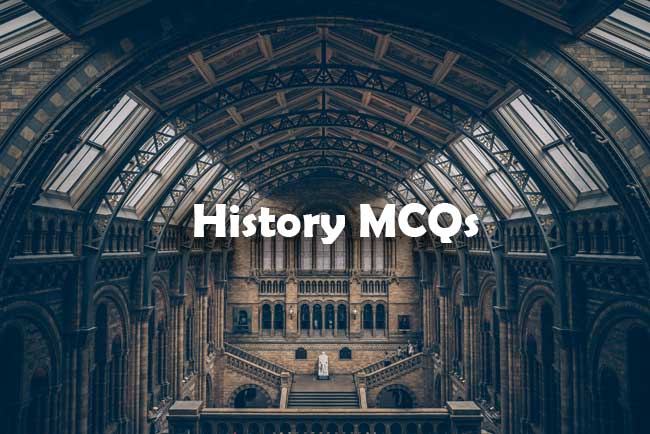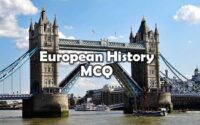History Quiz
History Quiz Questions and Answers papers are available here to download. This is the good news for the candidates who are preparing for history Quiz. Aspirants can download history Quiz pdf through online mode. Applicants who are preparing for history quiz can download history Quiz Sample questions from our website for free.

Aspirants who are seeking for history Quiz Sample Question Papers, for those candidates our site is the useful platform to get history Quiz questions Papers. With this history Quiz Papers, candidates can easily prepare for the exam. You can check these history Quiz and get an idea about model questions given in the written test.
Quiz on History
1. Early food-producing societies (farming societies) emerged in Baluchistan and northern fringes of Vindhyas in :
(A) 1000—500 BCE
(B) 7000—3000 BCE
(C) 3000—2000 BCE
(D) 2000—1000 BCE
2. The following scholar did not excavate any Harappan site :
(A) Rakhaldas Banerji
(B) Madho Swarup Vats
(C) Daya Ram Sahni
(D) V. Gordon Childe
3. The Harappan seals Were made from the material named :
(A) Chalcedony
(B) Steatite
(C) Quartz
(D) Lapis-Lazuli
4. ‘Adipurana’ was composed by :
(A) Somadeva
(B) Jinasena
(C) Varahamihir
(D) Ashvaghosha
5. In routine time-table of King, Kautilya divided night into …………. parts.
(A) Five
(B) Six
(C) Seven
(D) Eight
6. According to Jataka stories, Which of the following officers Were collecting taxes from the people ?
(A) Rajjuka and Dandin
(B) Bhagkara and Bhagaduta
(C) Tundiyas and Akasiyas
(D) Purohita and Rajacharya
7. Which new officer Was appointed by Ashoka during his reign ?
(A) Pradeshik
(B) Dharma Mahamatra
(C) Yukta
(D) Rajuka
8. The following site d0esn’t have rock-art :
(A) Maski
(B) Bhim-betka
(C) Piklihal
(D) Daimabad
9. Which of the following is not a part of Bhartriharfs Trishataka ?
(A) Niti Shatak
(B) Shringar Shatak
(C) Vairagya Shatak
(D) Achar Shatak
10. Which of the following pairs is correctly matched ?
(A) Samudragupta — Allahabad Pillar Inscription
(B) Skandagupta — Bhitari Pillar Inscription
(C) Buddhagupta — Eran Stone Pillar Inscription
(D) Chandragupta — Hathigumpha Inscription
11. Theory of ‘Shunyawada’ is attributed to :
(A) Upali
(B) Anand
(C) Nagarjun
(D) Bavari
12. Who employed broken men theory to explain emergence of untouchability in India 7
(A) G.S. Ghurye
(B) Dumont
(C) M.N. Shriniwasan
(D) Dr. B.R. Ambedkar
13. According to Dr. Ambedkar who was the author of Manu Samhita ?
(A) Vaivswat Manu
(B) Vyas
(C) Valmiki
(D) Sumati Bhargav
14. Which of the following Rashtrakuta rulers patronised Jainism ?
(A) Dantidurga
(B) Krishna II
(C) Amoghvarsha
(D) Krishna I
15. Which of the following historians has depicted Gupta age as golden age of India ?
(A) Romila Thapar
(B) D.N. Zha
(C) RC. Mazumdar
(D) RS. Sharma
16. Which of the following is not the feature of Indian feudalism ‘?
(A) Lord-Serf relationship
(B) Use of extra economic coercion
(C) Land grants as Agrahara and Brahmadeya
(D) Localization of trade
17. Who was the adoring deity of Alvar saints ?
(A) Shiva
(B) Shakti
(C) Vishnu
(D) Ram
18. The head of the military department during Delhi Sultanate was called as :
(A) Arz-i-Mumalik
(B) Sadr-us-Sadur
(C) Barid-i-Mumalik
(D) Amir Munshi
19. ‘Vishti’ is referred as …………….. ..
(A) King’s share
(B) A coin
(C) A unit area of land
(D) Forced labour
20. Which Mughal Emperor had introduced the ‘Duaspa-Sihaspa’ in Mansabdari system ?
(A) Akbar
(B) Jehangir
(C) Shah Jahan
(D) Aurangzeb
| MCQ | Hard Questions |
| GK | Basic Questions |
| Quiz | Trivia |
| Easy Questions |
21. The factor mainly responsible for Widespread revolts by the Jats, the Satnarnis, the Bundelas and the Sikhs after the reign of Aurangzeb was :
(A) The reactionary policy of Aurangzeb
(B) General discontent of the masses
(C) Agrarian crisis in the Mughal Empire
(D) The wars of succession and the consequent political crisis
22. Which one of the following Sufi sects adopted itself most to Indian conditions ?
(A) Naqshabandi
(B) Quadiri
(C) Suharawardi
(D) Chishti
23. What was meant by ‘Amaram’ in the Vijayanagar Empire ?
(A) Lease system of cultivation
(B) Territory assigned to military chiefs
(C) Lands donated to the Brahmins
(D) The chief judge after the king
24. In What Way did the internal administrative system of the Mughals contribute to the disintegration of the Empire ?
(A) The Nizam hastened the process of administrative collapse
(B) It Was highly centralized and could not be properly managed by incompetent rulers
(C) The Rajput chieftains again became powerful
(D) There was no proper co-ordination among the departments and the provinces
25. What is ‘ijarah’ ?
(A) Awarding the privilege of collection of land revenue to the highest bidder
(B) Collecting land revenue from temple lands
(C) Dividing the land on the pattern of cultivation
(D) All of the above
26. Who among the following believed that architecture, agriculture, tailoring and Weaving were “necessary crafts” ?
(A) Ibn-Khaldun
(B) Ibn-ul-Arabi
(C) Ibn Sena
(D) Al Jabr
27. Who was the author of “Travels in the Mughal Empire” ?
(A) Francois Bernier
(B) Niccollai Mannuci
(C) Abbe Carre
(D) Francisco Pelsaert
28. The Jahaz Mahal is in ……….. ..
(A) Dhaka
(B) Mandu
(C) Chaul
(D) Vengurla
29. The play ‘Matta-vilas-prahasana’ Was authored by ……………. .. .
(A) Harsha
(B) Raja Rajendra
(C) Jaidev
(D) Mahendravarman
30. What is ‘pietra dura’ ?
(A) A place where royal ladies stay
(B) The technique of inlaying mosaic with hard and precious stones
(C) Art of building domes on the Tombs
(D) Miniature paintings on the Wall
31. Where is the ‘Adhai-din-Ka Jhopra’ ?
(A) Ahmedabad
(B) Agra
(C) Jodhpur
(D) Ajmer
32. The battle of Wandiwash was fought between :
(A) the English and the French
(B) the English and the Marathas
(C) the English and Hyder Ali
(D) the English and the Carnatic Nawab
33. Who founded the Asiatic Society of Bengal in 1784 ?
(A) Warren Hastings
(B) William Jones
(C) Henry Princeps
(D) W.W. Hunter
34. Who said “Patriotism is religion and religion is love for India” ?
(A) Bankim Chandra Chatterjee
(B) Bal Gangadhar Tilak
(C) Vivekananda
(D) M.G. Ranade
35. Which among the following is not a reason for the requirement of increased Working capital credit for commercialization of agriculture ?
(A) Commercial agriculture needed more investment
(B) Payment of revenue was in kind
(C) To buy food before harvest, the peasant needed to borrow money
(D) Cash crops Were traded over long distances, so there Was a greater need for ready money
36. Gandhiji’s Champaran Movement Was started for :
(A) The Security of the Rights of Harijans
(B) To protect the Rights of Women
(C) To solve the Labour Problems
(D) To solve the Problem of Indigo-Workers
37. Rabindranath Tagore surrendered his knighthood to the British because of :
(A) Partition of Bengal
(B) Non-co-operation Movement
(C) Jallianwalla Bagh Massacre
(D) Civil Disobedience Movement
38. Who was the President of the Congress When it passed a resolution declaring “Poorna Swaraj” to be its future objective ?
(A) Motilal Nehru
(B) Balgangadhar Tilak
(C) Jawaharlal Nehru
(D) Aurobindo Ghosh
39. The first session of the All India Trade Union Congress held in Bombay in 1920 Was presided over by :
(A) V.V. Giri
(B) Lala Lajpat Rai
(C) Jawaharlal Nehru
(D) N.M. Joshi
40. Who of the following Was not an extremist leader of the Indian National Congress ?
(A) Lala Lajpat Rai
(B) Balgangadhar Tilak
(C) Gopal Krishna Gokhale
(D) Bipin Chandra Pal
| Ancient India | Modern India |
| Medieval India | World History |
41. Who Was associated With the struggle against Mulshi Dam ?
(A) Keshava Rao Jedhe
(B) Shankar Rao Deo
(C) Senapati Bapat
(D) Bhaskar Rao Jadhav
42. Who among the following is not part of the Congress Socialist Party ?
(A) Acharya Narendra Deo
(B) Ram Manohar Lohia
(C) Jayaprakash Narayan
(D) Keshav Rao Jedhe
43. Who started the Bhoodan Movement?
(A) Kakasaheb Kalelkar
(B) Achyut Patawardhan
(C) Jayaprakash Narayan
(D) Vinoba Bhave
44. The Morley-Minto Reforms of 1909 provided for the first time as ….. ..
(A) Separate state
(B) Separate communal electorate
(C) Separate educational system
(D) Dominion status
45. The Government of India Act of …………………. .. separated Burma from India.
(A) 1909
(B) 1919
(C) 1935
(D) 1937
46. “Farasi Prakash”, the Persian-Sanskrit dictionary, was compiled by :
(A) Krishnadasa
(B) Haridasa
(C) Purandaradasa
(D) Jaswant Das
47. Who argued that facts and interpretation are inseparable ?
(A) Leopold Von Ranke
(B) V.K. Rajwade
(C) E.H. Carr
(D) James Grant Duff
48. Which among the following is the correct statement about Arnold Toynbee’s theory ?
(A) Decline of civilization has three stages : breakdown, disintegration and dissolution
(B) Decline of civilization has three stages : disintegration, dissolution and rebirth
(C) Decline of civilization has two stages : disintegration and dissolution
(D) Decline of civilization has no stages
49. Which of the following historians was the first to argue that caste has a material basis ?
(A) Irfan Habib
(B) RS. Shanna
(C) A.S. Altekar
(D) V.R. Shinde
50. Who opined that “all history is contemporary history” ?
(A) E.H. Carr
(B) Croce
(C) Hegel
(D) Karl Marx
51. Marc Bloc and Lucien Febvre Were associated With .
(A) the Romanticist School
(B) the Annale’s School
(C) the Prussian historiography
(D) the Neo—Marxist historiography
52. The book — ‘Rise of Maratha Power’ Was authored by …………….. .. .
(A) R.G. Bhandarkar
(B) Vishnushashtri Chiplunkar
(C) M.G. Ranade
(D) D.K. Karve
53. The hypothesis of ‘the Drain of Wealth’ was first propounded by :
(A) Dadabhai Naoroji
(B) John Strachey
(C) Gopal Krishna Gokhale
(D) Lala Lajpat Rai
54. Who used Gramsci’s theory of ‘War of Position’ and ‘War of Manouevre’ in the writing of history ?
(A) Sumit Sarkar
(B) Bipin Chandra
(C) Satish Chandra
(D) Parth Chatterjee
55. Which tradition of historical thought upheld substantialism and humanism ?
(A) Arabic
(B) Indian
(C) Greek
(D) Asian
56. In which of the following theories do we find the concept of “Surplus value” ?
(A) Positivism
(B) Idealism
(C) Marxism
(D) Liberalism
57. The author of the book ‘Social Contract’ was :
(A) Voltaire
(B) Lenin
(C) Rousseau
(D) Churchill
58. The socio-economic and administrative system that emerged in Europe after the 5th century A.D. Was known as the ………………… ..
(A) Manorial system
(B) Byzantine system
(C) Commando system
(D) Roman judicial system
59. Durand line was between :
(A) British India—Russia
(B) British India—Afghanistan
(C) British India—China
(D) British India—Nepal
60. The book “History of the Decline and Fall of the Roman Empire” was authored by …………………. ..
(A) Edward Gibbon
(B) Oliver Goldsmith
(C) Lord Acton
(D) G.R. Elton
61. Fugitive Slave Acts of 1793 and 1850 Were passed in ……………. .. .
(A) Japan
(B) USA
(C) South Africa
(D) India
62. The British Parliament abolished slavery in the British Empire in the year ………………….. ..
(A) 1832
(B) 1834
(C) 1833
(D) 1842
63. The first major event of granting rights to people was the signing of ……………………… ..
(A) Magna Carta
(B) Bill of Rights
(C) Petition of Rights
(D) Declaration of Rights
64. At the instance of the Allies, the Ottoman Empire was dismembered in 1920 by the ……………….. ..
(A) Treaty of Versailles
(B) Treaty of Amiens
(C) Treaty of Sevres
(D) Treaty of Frankfurt
65. Who among the following Chinese Communist Party leaders, was the most prominent victim of the Cultural Revolution?
(A) Liu Shao-Chi
(B) Liu Yung Fu
(C) Liu Fang Wei
(D) Ho Lung
66. Which US President endorsed the Department of state’s decision to send volunteers overseas to meet the requirements for skilled manpower ?
(A) Harry S. Truman
(B) Theodore Roosevelt
(C) J.F. Kennedy
(D) George Bush
67. What do you understand by ‘Mulatto’?
(A) Escaped slaves
(B) A person of mixed race, usually with parents of European and African origin
(C) An African
(D) Long-distance trader
68. The turning point in the history of apartheid was de Klerk’s announcement in February ……. ..
(A) 1990
(B) 1991
(C) 1909
(D) 1919
69. Who wrote, “Man is born free, and everywhere he is shackled” ?
(A) Galileo Galilei
(B) Baron de Montesquieu
(C) Jean-Jacques Rousseau
(D) Adam Smith



